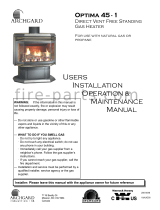
Searchpoint Optima Plus
Safety Manual
9
16. Conrm that a fault is generated on the 4-20 mA output, either locally or at the controller.
Note: The 4-20 mA output can be monitored either at the control room or locally with a multimeter. When
connecting or disconnecting a multimeter, power off the Searchpoint Optima Plus, otherwise the unit will
indicate a latched warning that the 4-20 mA loop was broken. If this occurs it can be cleared by performing
a Device Reset.
17. Remove the blockage from the beam.
18. Select Inhibit.
19. Select Start Inhibit and press Enter.
20. The display shows a conrmation message. Press OK. The 4-20 mA output is now inhibited.
21. Replace the Dust Barrier and Standard Weather Protection.
22. Select Device Reset to clear any faults or warnings that may have been generated by cleaning.
23. Press OK to initiate a Device Reset.
24. The display shows a conrmation message. Press OK.
25. The display shows a note that the Searchpoint Optima Plus will return to normal operation, press OK.
26. Select Inhibit.
27. Select End Inhibit and press Enter.
28. The display shows a conrmation message. Press OK to release the 4-20 mA output.
29. Return to the Welcome screen.
3.1.2 Inspection of a unit tted with a Flow Housing
Searchpoint Optima Plus should be inspected and cleaned.
Caution: Gas readings may be generated during this procedure. Follow the steps to inhibit the
4-20 mA output. Ensure that the unit is not left in Inhibit mode.
1. Select Device Setup.
2. Select Test.
3. Select Inhibit.
4. Select Start Inhibit and press Enter.
5. The display shows a conrmation message. Press OK. The 4-20 mA output is now inhibited.
6. Inspect the Searchpoint Optima Plus unit, its junction box and cabling for any signs of physical damage.
7. Disconnect any pipework attached to the ow housing.
8. Using a ½ inch / 13 mm A/F open ended spanner, remove the two black nuts which retain the ow
housing. Keep the O-ring seals which are below the retaining nuts.
9. Slide the ow housing off the Searchpoint Optima Plus. This may require some force due to the friction
of the O-ring.
10. Clean any dust or contaminants from the optics using mild detergent and a soft cloth or cotton bud.
Do not use solvents or abrasive cleaners.
11. Select Inhibit.
12. Select End Inhibit and press Enter.
13. The display shows a conrmation message. Press OK to release the 4-20 mA output.
14. Block the optical beam (for example using the cleaning cloth).
3. Proof test using HART® Communications


















